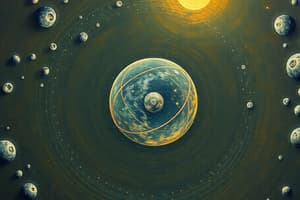Podcast
Questions and Answers
What are the three main parts that make up an atom?
What are the three main parts that make up an atom?
- Electrons, protons, and neutrons (correct)
- Photons, electrons, and protons
- Molecules, ions, and isotopes
- Neutrons, isotopes, and protons
According to Bohr's model, where do electrons move around?
According to Bohr's model, where do electrons move around?
- Around the atomic nucleus in specific paths called electron shells (correct)
- Inside the nucleus with protons and neutrons
- In straight lines away from the nucleus
- In a random pattern with no defined paths
What happens when electrons jump from one layer to another in an atom?
What happens when electrons jump from one layer to another in an atom?
- They release light energy as they fall back down into the lower shells (correct)
- They increase in speed
- They combine with protons
- They disappear momentarily
How many electrons can each orbital path in an atom hold?
How many electrons can each orbital path in an atom hold?
What determines the width of each electron shell in an atom according to Bohr's model?
What determines the width of each electron shell in an atom according to Bohr's model?
How do spectral lines help scientists figure out what elements things are made of?
How do spectral lines help scientists figure out what elements things are made of?
Flashcards are hidden until you start studying
Study Notes
Atoms are extremely small objects that make up everything around us. They are so small you need a microscope to see them! An atom is made of three main parts: protons, neutrons, and electrons. Protons have a positive charge, neutrons do not have any charge, and electrons have a negative charge. Electrons move very fast around the nucleus which has protons and neutrons inside it.
In 1913, Danish physicist Niels Bohr came up with his famous 'Bohr Model'. It explained how atoms work by connecting their size, shape, and behavior. In this model, electrons orbit the atomic nucleus in specific paths called electron shells. Each orbital path holds only two electrons. The number of electron shells increases when an element gains more electrons. This creates different layers surrounding the nucleus. For example, hydrogen gas contains one layer while gold has seven layers.
The energy level of each shell determines its width. If there is enough space between the outermost shell and the next inner shell, electrons will stay outside because they don't want to lose energy. But if those two layers get closer together, electrons can jump from one layer to another, releasing light energy as they fall back down into the lower shells. When this happens, we say we are seeing 'spectral lines'. These spectral lines help us figure out what elements things are made of. Different energies produce different colors of light, like red or yellow. So by looking at these colors, scientists know what kind of matter something is composed of.
Studying That Suits You
Use AI to generate personalized quizzes and flashcards to suit your learning preferences.



